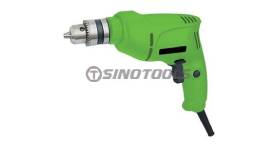An electric drill is a tool commonly used in the machinery industry, construction industry, and decoration industry to drill holes, punch screws and lift screws. In the 19th century, Austrians Arthur James Arnot and William Blanch Brain invented the first electric drill by combining an electric motor with a drill. In 1889, Wilhelm Fein invented the portable electric drill in Melbourne, Australia. In 1917, German Black and Decker invented an electric drill with a pistol handle and trigger. This electric drill with trigger continues to this day.
Electric drill mainly consists of an electric motor, reduction box, handle, drill chuck, or conical sleeve and power connection device.
Electric drill type:
Type A electric drill: mainly used for drilling common steel, it has higher drilling productivity, general requirements, and applicability of strong, complete specifications, generally using two-speed change.
Type B electric drill: mainly used for drilling high-quality steel and all kinds of steel, with high drilling productivity. The rated output power and torque of this type of electric drill are larger than that of type A and have A strong overload capacity. The speed is similar to that of type A.
Type C electric drill: mainly used for drilling aluminum, copper, and other non-ferrous metals and their alloys, plastics, and cast iron and other materials, and has high drilling productivity, but also can be used for ordinary steel drilling also. The electric drill is characterized by its lightweight and simple structure.

Electric Drill
The use of electric drill tools:
1. Use the specified voltage. The line voltage used by the electric drill shall not exceed ±10% of the voltage specified on the nameplate of the electric drill.
2. Use of drill chuck and taper sleeve. Electric drills under 19 mm usually use a three-jaw bit clamp, which is specially designed and manufactured for electric drills. The electric drill above 19 mm generally adopts the conical sleeve. When installing the bit, first clear the bit hole and the surface of the drill shaft sundries, including rust grease, and then install the bit on the drill shaft.
3. Check before use:
A. Check whether the transmission part is flexible, there is no noise, and whether the commutation spark is normal.
B, before use must use 500 v measurement insulation resistance by megger are, around the level between the casing and the insulation must be greater than 0.5 M Ω.
C. Overload is strictly prohibited when using the electric drill.
D. If the electric drill brush is seriously worn, the brush should be replaced in time, which will cause damage to the commutator and seriously burn the armature.
E. the electric drill shall not continue to be used if one of the following situations occurs in the process of use:
Power cord insulation damage and cable sheath are broken.
The power plug, socket bad contact.
(3) there is an abnormal sound in the process of operation.
The brush and commutator spark too big to cause a ring fire.
(5) bearing temperature and armature temperature overheating.
没有评论:
发表评论